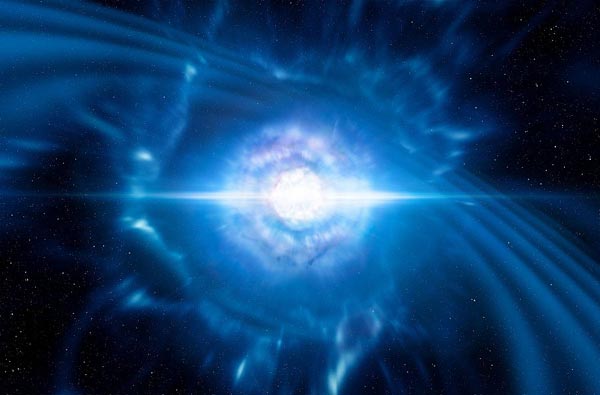In first, scientists detect light from gravitational wave source
 |
This handout image obtained from the European Southern Observatory on October 16, 2017 is an artists impression showing two tiny but very dense neutron stars at the point at which they merge and explode as a kilonova. [Photo/VCG] |
CAMBRIDGE, Mass. - Scientists have for the first time detected gravitational waves, the ripples in space and time predicted by Albert Einstein, at the same time as light from the same cosmic event, according to research published on Monday.
The waves, caused by the collision of two neutron stars some 130 million years ago, were first detected in August by the Laser Interferometer Gravitational-Wave Observatories, known as LIGO, in Washington state and Louisiana as well as at a third detector, named Virgo, in Italy.
Two seconds later, observatories across earth and in space detected a burst of light in the form of gamma rays from the same part of the southern sky, which analysis showed was likely to be from the same source.
The observations found that gold, platinum and other heavy metals were blown into space by the aftermath of the merger of the stars, confirming that such cataclysmic events are likely the source of these metals.
Less than two years have passed since scientists working at the Massachusetts Institute of Technology and the California Institute of Technology first detected gravitational waves coming off two black holes.
The gravitational waves had been predicted by Einstein in 1916, as an outgrowth of his groundbreaking general theory of relativity, which depicted gravity as a distortion of space and time triggered by the presence of matter.
Three US scientists who made that discovery were awarded the Nobel prize in physics earlier this month.
The findings published on Monday help confirm Einstein's theory, said the researchers.
"Imagine that gravitational waves are like thunder," astronomer Philip Cowperthwaite, of the Harvard-Smithsonian Center for Astrophysics, said in a statement. "We've heard this thunder before, but this is the first time we've also been able to see the lightning."
The LIGO instruments work in unison and use lasers to detect remarkably small vibrations from gravitational waves as they pass through the earth.
Previously, scientists could only study space by observing electromagnetic waves such as radio waves, visible light, infrared light, X-rays and gamma rays. Those waves encounter interference as they travel across the universe, but gravitational waves do not, meaning they offer a wealth of additional information.
The colliding neutron stars were smaller than the black holes that LIGO previously detected.
Neutron stars are relatively small, about the size of a city, the compact remains of a larger star that died.
The National Science Foundation, an independent agency of the U.S. government, provided about $1.1 billion in funding for the LIGO research over 40 years.
Reuters
Your Comment
Name E-mailRelated News
-
;
Based in Lhasa, Tibet Vista is a Tibet travel agency that specialized in Tibet permit, and Tibet tours for both private and group travelers at a local price!
•4 Days Lhasa City Group Tour from USD 460 •8 Days Everest Base Camp Group Tour from USD 850 •15 Days Mt.Kailash Group Tour from USD 1780 •2016 Tibet Train Tours from Beijing, Shanghai, Chengdu, Xining,etc










